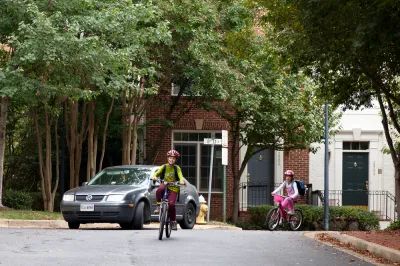Without children at the center of activity, the urban neighborhoods of today offer little compared to the ideals expressed by Jane Jacobs, according to this strongly worded critique of contemporary urbanism.

Benjamin Schwarz begins a critique of what he calls the Vibrant Urban Neighborhood with the following description of his subject: "its standard-issue bike shops and vintage clothiers, its 'authentic' live-work spaces and dive bars, its predictable purveyors of vinyl records and locally-sourced foodstuffs, its de rigueur venues for generically hip 'live music,' its uniform throngs of overwhelmingly unmarried and childless active or aspiring knowledge workers ritualistically intoning the shibboleth of 'diversity'…"
Instead of the renaissance many urbanists describe, the increasing popularity of Vibrant Urban Neighborhoods, or VUNs, "merely demonstrates that consumption and entertainment have become the dominant means of self-definition and of what passes for political expression—and, concomitantly, it signifies not the triumph of urban life but of our crabbed vision of the promise and potentialities of neighborhood and community."
To further describe where the urban renaissance has gone wrong, Schwartz compares contemporary urban neighborhoods to those extolled by Jane Jacobs. According to Schwartz, children are the component most lacking from contemporary neighborhoods. In fact, the bulk of the argument contained in the column is devoted to reframing the importance of children in some of Jacobs's most famous passages, and achieving an accurate comparison of the "urban villages" of her day with the VUNs of ours.
By discussing children, Schwartz also enters into an ongoing debate about the long-term appeal of urban environments to families as they age and grow. Planetizen blogger Michael Lewyn recently wrote about the complex demographic trends unfolding for families in and around cities. Other recent stories have lamented the lack of priority given to children in setting an urban agenda in Oakland, California, and provided statistical analysis of the U.S. cities with the most children.
FULL STORY: Cities Without Children

National Parks Layoffs Will Cause Communities to Lose Billions
Thousands of essential park workers were laid off this week, just before the busy spring break season.

Retro-silient?: America’s First “Eco-burb,” The Woodlands Turns 50
A master-planned community north of Houston offers lessons on green infrastructure and resilient design, but falls short of its founder’s lofty affordability and walkability goals.

Delivering for America Plan Will Downgrade Mail Service in at Least 49.5 Percent of Zip Codes
Republican and Democrat lawmakers criticize the plan for its disproportionate negative impact on rural communities.

Test News Post 1
This is a summary

Test News Headline 46
Test for the image on the front page.

Balancing Bombs and Butterflies: How the National Guard Protects a Rare Species
The National Guard at Fort Indiantown Gap uses GIS technology and land management strategies to balance military training with conservation efforts, ensuring the survival of the rare eastern regal fritillary butterfly.
Urban Design for Planners 1: Software Tools
This six-course series explores essential urban design concepts using open source software and equips planners with the tools they need to participate fully in the urban design process.
Planning for Universal Design
Learn the tools for implementing Universal Design in planning regulations.
EMC Planning Group, Inc.
Planetizen
Planetizen
Mpact (formerly Rail~Volution)
Great Falls Development Authority, Inc.
HUDs Office of Policy Development and Research
NYU Wagner Graduate School of Public Service





























